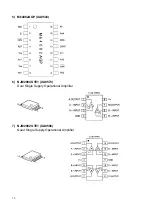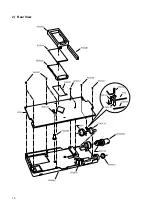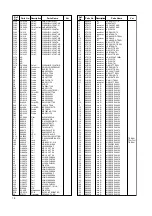
3
CIRCUIT DESCRIPTION
1) Receiver System
The receiver system is a double superheterodyne system with a 21.7MHz first IF and a 450kHz second IF.
1. Front End
The received signal at any frequency in the 130.00- to 173.995-MHz range is
passed through thelow-pass filter (L2, L3, L11, C13, C14, C15 and C60) and
tuning circuit (L16 and D15), and amplified by the RF amplifier (Q11). The
signal from Q11 is then passed through the tuning circuit (L17, L18, L19 and
varicaps D13, D14 and D16) and converted into 21.7MHz by the mixer (Q9).
The tuning circuit, which consists of L16, L17, varicaps D15 and D13, L18,
L19, varicaps D14 and D16, is controlled by the tracking voltage form the CPU
so that it is optimized for the reception frequency. The local signal from the VCO
is passed through the buffer (Q13), and supplied to the source of the mixer
(Q9). The radio uses the lower side of the superheterodyne system.
2. IF Circuit
The mixer mixes the received signal with the local signal to obtain the sum of
and difference between them. The crystal filter (XF1, XF2) selects 21.7MHz
frequency from the results and eliminates the signals of the unwanted frequen-
cies. The first IF amplifier (Q10) then amplifies the signal of the selected fre-
quency.
3. Demodulator Circuit
After the signal is amplified by the first IF amplifier (Q10), it is input to pin 16 of
the demodulator IC (IC5). The second local signal of 21.25MHz (shared with
PLL IC reference oscillation), which is oscillated by the internal oscillation cir-
cuit in IC1 and crystal (X1), is input through pin 1 of IC5. Then, these two
signals are mixed by the internal mixer in IC5 and the result is converted into
the second IF signal with a frequency of 450kHz. The second IF signal is output
from pin 3 of IC5 to the ceramic filter (FL1), where the unwanted frequency
band of that signal is eliminated, and the resulting signal is sent back to the IC5
through pins 5.
The second IF signal input via pin 5 is demodulated by the internal limiter
amplifier and quadrature detection circuit in IC5, and output as an audio signal
through pin 10.
4. Audio Circuit
The audio signal from pin 10 of IC5 is compensated to the audio frequency
characteristics in the de-emphasis circuit (R104, R103, C122, C121) and am-
plified by the AF amplifier (Q26). The signal is then input to pin 2 of the elec-
tronic volume (IC4) for volume adjustment, and output from pin 1. The adjusted
signal is sent to the audio power amplifier (IC3) through pin 2 to drive the
speaker.
Содержание DJ-195
Страница 2: ......
Страница 11: ...10 3 M5222FP 600C XA0385 Electronic Volume ...
Страница 12: ...11 4 TK14521MTL XA0515 IF System ...
Страница 14: ...13 8 S 81250SG QD T1 XA0619 Top View 9 S 80845ALMP EA9 T2 XA0620 Voltage Regulator ...
Страница 16: ...15 EXPLODED VIEW 1 Front View www ALIMCO ru ...
Страница 17: ...16 2 Rear View ...
Страница 28: ......
Страница 29: ...27 PC BOARD VIEW MAIN SIDE A MAIN Side B ...
Страница 30: ...28 SCHEMATIC DIAGRAM ...
Страница 31: ...29 BLOCK DIAGRAM www ALIMCO ru ...
Страница 32: ......
Страница 33: ......





































